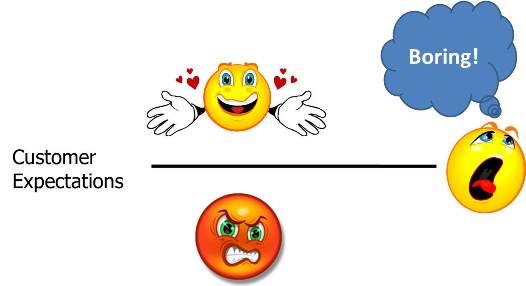Advertising disclosure: This blog participates in the Amazon Services LLC Associates Program, an affiliate advertising program designed to provide a means to earn fees by linking to Amazon and affiliated sites.
The lone cashier answered the phone while she rang up another customer's purchase. She seemed detached from both interactions, as she split her focus between the customer in front of her and the one on the phone.
I could only hear one side of the phone conversation. "The truck comes in today," said the cashier. (Scans an item.)
"I don't know what's on it." (Scans another item.)
"About half will be stocked by tonight." (Scan.)
"I don't know what's on it." (Points out order total to customer in front of her.)
"It will be here in about an hour." (Mouths "thank you" to customer in front of her as she hands him a receipt.)
This has become a normal service interaction. Companies are woefully understaffed. Customers can't get the information they want. Inventory is unpredictable and shipments are frequently delayed.
Are customers okay with this? The short answer is, "No."
How customer expectations have shifted
I launched a LinkedIn poll to ask people whether their expectations as a customer had shifted during the pandemic. It's a small sample size, just 143 participants, but the responses are revealing.
The comments point to two general trends.
Customers are making a concerted effort to be more patient and empathetic.
They also expect businesses to continue treating them as valued customers, and do a better job of communicating changes to normal service levels.
Kate: "My empathy has increased. Maybe most of all for the farmers from whom I buy my food. But for everyone–I think it’s a safe assumption that every business or customer support person I interact with is struggling in some way, facing some hardship."
Rama: "I don't expect less–I do understand that every part of a transaction may have slowed down, but that just means I expect communication to be improved. Not necessarily more personal or faster; just complete information, even if it's in autoresponder format."
Margie: "I think I’m getting a bit tired of hearing from businesses, 'Well due to COVID our wait times will be longer...' 'Due to COVID..this and that...' It’s as if COVID is the excuse for everything. How long is this a viable excuse for service issues?"
Namecca: "My patience has drastically increased. As an efficiency lunatic, I used to see all the flaws in the process and get frustrated in traffic, in line, at the store, etc. Now it just is what it is. Flexible, more compassion and definitely more deliberate actions in my personal life. I still expect that people show up to do a good job but when they don't or can't I am more forgiving for sure."
Bryan: "It's heartbreaking to see so many businesses, mostly restaurants, fold during this time. I both respect and understand the levels of change they have to bring everyday to just survive."
Resources to improve service
Nearly every company was in some sort of survival mode in March. They were either fighting to stay in business, like restaurants, or were completely overwhelmed with business, like grocery stores.
Now we're more than five months into the pandemic. Companies need a better, more long-term solution. The alternative is losing even more customers to competitors that are better able to adapt.
The starting point is a customer service vision. This is a shared definition of outstanding service that gets everyone on the same page. If you want your team to be great, you must first define greatness.
These resources can help you:
Another essential step is to better manage customer expectations. This includes clear, proactive communication to let customers know what's changed.
This LinkedIn Learning course can help you. You can access the course with your LinkedIn Learning subscription or get a 30-day trial.






